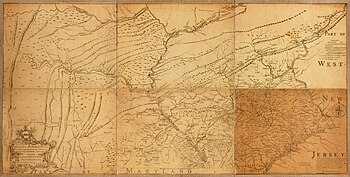
The Kittanning Expedition, also known as the Armstrong Expedition or the Battle of Kittanning, was a raid during the French and Indian War that led to the destruction of the American Indian village of Kittanning, which had served as a staging point for attacks by Lenape warriors against colonists in the British Province of Pennsylvania. Commanded by Lieutenant Colonel John Armstrong Sr., this raid deep into hostile territory was the only major expedition carried out by Pennsylvanian provincial troops during a brutal backcountry war. Early on September 8, 1756, they launched a surprise attack on the Indian village.

Fort Loudoun was a fort in colonial Pennsylvania, one of several forts in colonial America named after John Campbell, 4th Earl of Loudoun. The fort was built in 1756 during the French and Indian War by the Second Battalion of the Pennsylvania Regiment under Colonel John Armstrong, and served as a post on the Forbes Road during the Forbes expedition that successfully drove the French away from Fort Duquesne. The fort remained occupied through Pontiac's War and served as a base for Colonel Henry Bouquet's 1764 campaign. In the 1765 Black Boys Rebellion, Fort Loudoun was assaulted by angry settlers, when their guns were confiscated after they destroyed supplies intended for Native Americans. The garrison retreated to Fort Bedford and the fort was abandoned.
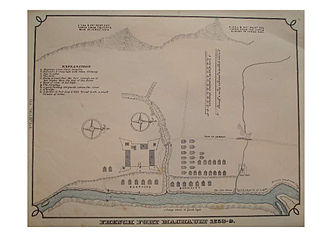
Fort Machault was a fort built by the French in 1754 near the confluence of French Creek with the Allegheny River, in northwest Pennsylvania. The fort helped the French control these waterways, part of what was known as the Venango Path from Lake Erie to the Ohio River. It was one of four forts designed to protect French access to the Ohio Country and connections between its northern and southern colonies. From north to south the forts were Fort Presque Isle, Fort Le Boeuf, Fort Machault, and Fort Duquesne, at the Forks of the Ohio. The fort was abandoned by the French in 1759, and burned so that the British could not use it. It was replaced by the British in 1760 with Fort Venango.
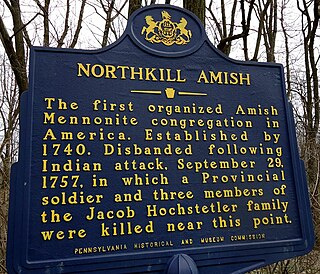
The Northkill Amish Settlement was established in 1740 in Berks County, Pennsylvania. As the first identifiable Amish community in the new world, it was the foundation of Amish settlement in the Americas. By the 1780s it had become the largest Amish settlement, but declined as families moved elsewhere.

The Conrad Weiser Homestead was the home of Johann Conrad Weiser, who enlisted the Iroquois on the British side in the French and Indian War. The home is located near Womelsdorf, Berks County, Pennsylvania in the United States. A designated National Historic Landmark, it is currently administered as a historic house museum by the Pennsylvania Historical and Museum Commission. The historic site was established in 1923 to preserve an example of a colonial homestead and to honor Weiser, an important figure in the settlement of the colonial frontier.
Manada Gap is an unincorporated community in East Hanover Township, Dauphin County, Pennsylvania, United States, located in the Harrisburg-Carlisle area, near Fort Indiantown Gap.
Northkill Creek is a stream primarily located in Berks County, Pennsylvania. It feeds into Tulpehocken Creek and covers part of the Schuylkill River and Delaware River watersheds. Northkill Creek and its tributaries are high quality trout streams.
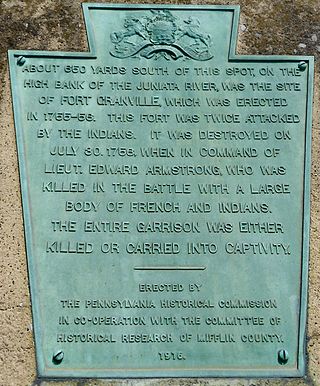
Fort Granville was a militia stockade located in the colonial Province of Pennsylvania. Its site was about a mile from Lewistown, in what is now Granville Township, Mifflin County. Active from 1755 until 1756, the stockade briefly sheltered pioneer settlers in the Juniata River valley during the French and Indian War. The fort was attacked on August 2, 1756, by a mixed force of French troops and Native Americans, mostly Lenape warriors. The fort’s garrison surrendered the strongpoint to these attackers, who celebrated their victory and destroyed the stockade.

Fort Shirley was a military fort located in present-day Shirleysburg, Pennsylvania. It was built in 1755 by George Croghan and later maintained by the Province of Pennsylvania during the French and Indian War. Fort Shirley was part of a defensive line of forts built in Pennsylvania during 1755 and 1756, at the start of hostilities with the French and their allied Native Americans. Although two French and Native American war parties were sent to capture it, Fort Shirley was never attacked. The fort served as the launching site for the Kittanning Expedition in September 1756, after which it was abandoned.

The Hochstetler massacre was an attack on a farmstead at the Northkill Amish Settlement in September or October 1757, in which three Amish settlers were killed and three others taken into captivity. The attack was one of many assaults by French-allied Native American warriors on Pennsylvania settlements during the French and Indian War. For religious reasons, the Amish settlers refused to defend themselves, and everyone in the homestead was either killed or captured. One of the captives, 45-year-old Jacob Hochstetler, escaped captivity after about eight months, and his two sons were later returned through a peace agreement brokered in 1763.
William Clapham was an American military officer who participated in the construction of several forts in Pennsylvania during the French and Indian War. He was considered a competent commander in engagements with French troops and Native American warriors, but towards the end of his military career he was unpopular with troops under his command. Following his retirement from the army, he and his family were killed by Lenape warriors on his farm in 1763.

Provincial troops were military units raised by colonial governors and legislatures in British North America for extended operations during the French and Indian Wars. The provincial troops differed from the militia, in that they were a full-time military organization conducting extended operations. They differed from the regular British Army in that they were recruited only for one campaign season at the time. These forces were often recruited through a quota system applied to the militia. Officers were appointed by the provincial governments. During the eighteenth century militia service was increasingly seen as a prerogative of the social and economic well-established, while provincial troops came to be recruited from different and less deep-rooted members of the community.

Fort Vause was built in 1753 in Montgomery County, Virginia, by Ephraim Vause. The historic site is near the town of Shawsville, Virginia. It was attacked by French troops and Native American warriors in 1756, and most of the inhabitants were killed or taken prisoner. The fort was rebuilt in 1757 but abandoned by 1759.

The Bloody Springs massacre was an attack by Lenape warriors on homesteads in what is now Berks County, Pennsylvania, on October 1, 1757, during the French and Indian War. The Spatz family and other settlers were killed at a spring near modern-day Strausstown, Pennsylvania, causing the water to run red with the blood of the family. The story of the massacre has been passed down through the Degler family, whose farm was adjacent to the Spatz homestead.
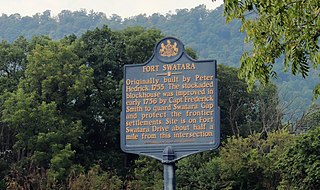
Fort Swatara was a stockaded blockhouse built during the French and Indian War in what is now Lebanon County, Pennsylvania. Initially a farmstead surrounded by a stockade, provincial troops occupied it in January 1756. The fort safeguarded local farms, but a number of settlers were killed by small Native American war parties. The fort was abandoned in May 1758.
The Sandy Creek Expedition, also known as the Sandy Expedition or the Big Sandy Expedition, was a 1756 campaign by Virginia Regiment soldiers and Cherokee warriors into modern-day West Virginia against the Shawnee, who were raiding the British colony of Virginia's frontier. The campaign set out in mid-February, 1756, and was immediately slowed by harsh weather and inadequate provisions. With morale failing, the expedition was forced to turn back in mid-March without encountering the enemy.
Fort Allen was a military structure built in Franklin Township, in Carbon County, Pennsylvania in 1756. It was first of several frontier defenses erected by Benjamin Franklin for the Province of Pennsylvania during the French and Indian War. The garrison was rarely more than fifty men, and the fort never saw combat, however it became a center of contact and trade with Native Americans and served as a stopping point for Indians traveling to and from Bethlehem, Easton and Philadelphia. It was abandoned in 1761 near the end of the French and Indian War, and briefly reoccupied during Pontiac's War and again during the American Revolutionary War.
Fort Hunter was a military fort located in present-day Fort Hunter, Pennsylvania. It was initially a stockaded gristmill fortified by Samuel Hunter in 1755 and later enlarged and maintained by the Province of Pennsylvania during the French and Indian War. Fort Hunter was part of a defensive line of forts built in Pennsylvania during 1755 and 1756, at the start of hostilities with the French and their allied Native Americans. It was briefly used during Pontiac's War, then abandoned in 1763.

Fort Northkill was a fort in colonial Pennsylvania, built to protect settlers from attacks by French-allied Native Americans during the French and Indian War. Although the fort was garrisoned by Pennsylvania militia, they were unable to prevent continued attacks on local farmsteads, but the fort did provide some protection for the settlers themselves. The fort appears to have been abandoned in September 1757, but the exact date is unknown.
Fort Henry was a stockade fort built in early 1756 in Berks County, Pennsylvania, to protect local settlers from Native American war parties, which were raiding the area frequently during the French and Indian War. It was one of the larger forts built in a defensive line, 12-20 miles apart, intended to safeguard the more densely-populated communities of the eastern Province of Pennsylvania. It was abandoned in 1759, and then briefly put back into use in 1763 during Pontiac's War.

